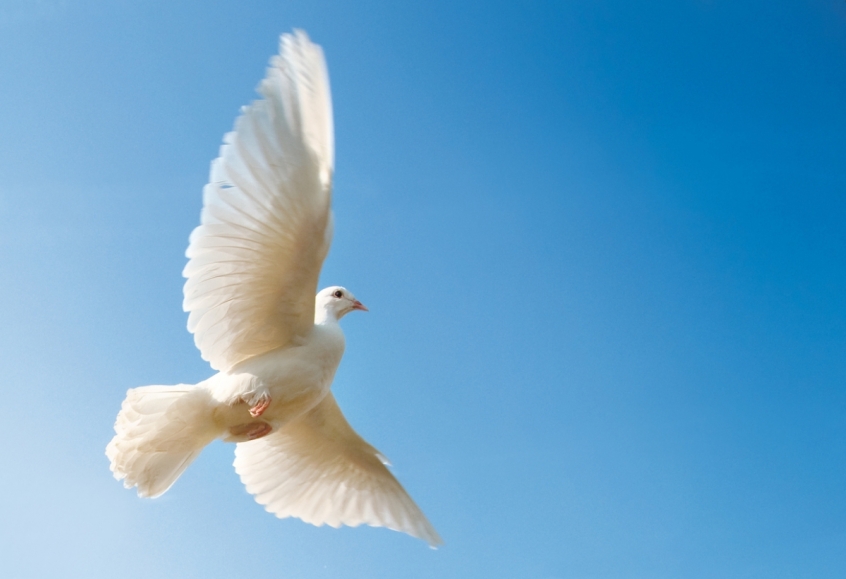
There are three common symbols of the Holy Spirit which are wind, fire, and the dove. This is the story …
Wind or Breath
The Holy Spirit is likened to wind or breath. In Hebrew and Greek, the word for breath and spirit is the same, whether ‘ruach’ in Hebrew or ‘pneuma’ in Greek. At creation God breathed spirit into mankind. The Bible says that God formed a man from the dust of the ground and breathed into his nostrils the breath of life, and man became a living being (Genesis 2:7).
Later we have the analogy of the Holy Spirit with wind. Jesus explained that the wind blows wherever it pleases. Jesus said that you can hear the sound of wind, but you cannot tell from where it is coming or to where it is going: “So, it is with everyone born of the Spirit” (John 3:8, NIV).
Then the Holy Spirit came like wind at Pentecost. It was said to sound like a violent wind blowing in from heaven, and it filled the whole place where they sat: “All of them were filled with the Holy Spirit and began to speak in other tongues as the Spirit enabled them” (Acts 2:2). The Spirit arrived like a rushing wind (Acts 2:2), signifying life, power, and the invisible but real presence of the Spirit.Wind is strong and powerful and cannot be controlled by mankind. So, it is with the Holy Spirit. Rather like electricity and love, you cannot see wind physically, but you can see and feel its effects to know it is there.
Flames or Fire
Another symbol of the Holy Spirit is the flame or fire. At Mount Sinai Moses met the angel of the Lord who appeared to him in the flames of fire from within a bush. Moses saw that though the bush was on fire it did not burn (Exodus 3:2-3). The burning bush has been used as a symbol by some Christian groups. Its adoption dates to the French Huguenots (Reformed Church of France) in 1583, who chose it as a symbol of the Church's endurance through persecution, accompanied by the motto "I am burned but not consumed" (Flagror non consumor).
John Calvin used the burning bush as a metaphor for the Church enduring persecution but never being destroyed, as it is sustained by God’s presence rather than its own strength. Today the burning bush is used as a symbol by many Presbyterian churches which come out of the Scottish Calvinist tradition.
John the Baptist baptised with water for repentance, but he said that Jesus would baptise with the Holy Spirit and fire” (Matthew 3:11, Luke 3:16). Then at Pentecost in the Upper Room, the gathered disciples saw what seemed to be tongues of fire that separated and came to rest upon them. It says that all of them were filled with the Holy Spirit and began to speak in other tongues as the Spirit enabled them (Acts 2:2-4). Today fire is a symbol of The Salvation Army which has “Blood and Fire” as the motto of its crest and flag. The flame is also a symbol of the United Methodist Church (UMC) in the USA, which combines a flame with the cross.Fire has the sense of holiness in the Old Testament. The burning bush never burnt out and God’s fire cannot be extinguished. In metalwork fire purifies metal and burns off impurities. We may have a spark of the Holy Spirit in us, but it needs to be ignited to set us on fire for God. Fire symbolises transformation, purification, energy, and the empowering force of the Spirit.
The Dove
The dove is another symbol of the Holy Spirit. In the story of Noah, we read that when the dove returned in the evening, it had a freshly plucked olive leaf in its beak. That enabled Noah to know that the water had receded from parts of the earth (Genesis 8:11). From this story the dove has become an international symbol of peace which has been used by the United Nations. At the baptism of Jesus, we read that Jesus was baptised by John the Baptist and as Jesus was coming up out of the water, he saw heaven opening and the Spirit descend upon him like a dove (Matthew 3:6; Mark 1:9-10; Luke 3:22; John 1:32). Some Christians wear a dove as a badge, especially those from Pentecostal or charismatic traditions.
In the ark the dove brought the first proof of life to Noah, and the Holy Spirit is proof of life with God. Doves are white and white was symbolic as a colour of holiness and purity. In the Old Testament the priests wore white linen garments to signify their readiness to enter God’s holy presence (Exodus 28:39), and angels are often described as clothed in white (Daniel 7:9, Revelation 7:9, 14).
The prophet Isaiah uses the metaphor of sins being like scarlet, but purity being white like snow or wool (Isaiah 1:18) to illustrate God’s power to cleanse and forgive, turning impurity into purity. Doves come bringing peace, and the Holy Spirit brings peace, and Jesus is Prince of Peace. The dove represents purity, peace, and the gentle presence of the Spirit.
Summary
There are three biblical symbols of the Holy Spirit found in the Old Testament and in the New Testament. These three symbols are deeply rooted in Scripture and Christian tradition. They have been used through history by Orthodox, Catholic and Protestant Christians. They help us understand and visualise the many ways the Holy Spirit is present and active in the world and in the lives of believers.













